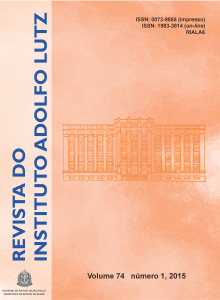Resumo
Doenças infecciosas em pacientes renais podem ser associadas à qualidade da água de diálise, que pode apresentar contaminação com microrganismos. Pelos padrões brasileiros, a qualidade da água é avaliada analisando-se coliformes totais, bactérias heterotróficas e endotoxinas bacterianas. Pseudomonas sp. e fungos não são investigados. Amostras de água de clínicas de hemodiálise em Curitiba/PR foram avaliadas quanto à conformidade com os padrões do Ministério da Saúde. Contagens de coliformes totais, bactérias heterotróficas, Pseudomonas aeruginosa e fungos foram realizadas seguindo-se APHA e detecção de endotoxina pela metodologia LAL. Todas as amostras tiveram contagens de coliformes totais abaixo de 1,1 MPN/100 mL e ≥ 95 % das amostras apresentaram padrões aceitáveis para bactérias heterotróficas. P. aeruginosa foi encontrada em quatro amostras. Em 15 % das amostras, endotoxinas bacterianas foram detectadas em valores acima dos permitidos pela legislação. Leveduras foram isoladas em 26 % das amostras e fungos filamentosos em 58 %, sendo 46 % melanizados e 27 % hialinos. Os gêneros fúngicos detectados foram Cladosporium spp., Penicillium spp., Beauveria spp., Exophiala spp., Fusarium spp., Aspergillus spp., Trichoderma spp, Acremonium spp. e Rinocladiella spp.. Foi evidenciada a importância da detecção de P. aeruginosa e fungos nestes sistemas, uma vez que estes podem ser potencialmente patogênicos para pacientes imunocomprometidos.Referências
1. Sesso RC, Lopes AA, Thomé FS, Lugon JR, Santos DR. Relatório do censo brasileiro de diálise de 2010. J Bras Nefrol.2011;33(4):442-7. http://dx.doi.org/10.1590/S0101-28002011000400009
2. Sesso R, Lopes AA, Thomé FS, Bevilacqua JL, Romão Jr JE, Lugon J. Relatório do Censo Brasileiro de Diálise, 2008. J Bras Nefrol.2008;30(4):233-8.
3. De Filippis P, Spitaleri G, Damiani F, Panà A. Microbiological quality of haemodialysis water in various hospitals and private clinics in the Lazio region (Italy): 2000-2004. Ig Sanita Pubbl.2007;63(1):21-9.
4. Figel IC, Marangoni PRD, Tralamazza SM, Vicente VA, Dalzoto P do R, do Nascimento MM, et al. Black yeasts-like fungi isolated from dialisys water from Brazilian hemodialysis units. Mycopathol.2013;175(5-6):413-20. doi: 10.1007/s11046-013-9633-4
5. Schindler R, Christ-Kohlrausch F, Frei U, Shaldon S. Differences in the permeability of high-flux dialyzer membranes for bacterial pyrogens. Clin Nephrol.2003;59(6):447-54.
6. Brasil. Resolução RDC nº 154, de 15 jun. 2004. Estabelece o Regulamento Técnico para o funcionamento dos Serviços de Diálise. Diário Oficial [da] União, Brasília, DF, 17 jun 2004.
7. Montanari LB, Sartori FG, Cardoso MJO, Varo SD, Pires RH, Leite CQF, et al. Microbiological contamination of a hemodialysis center water distribution system. Rev Inst Med Trop S Paulo.2009;51(1):37-43. http://dx.doi.org/10.1590/S0036-46652009000100007
8. Pires-Gonçalves RH, Sartori FG, Montanari LB, Zaia JE, Melhem MS, Mendes-Giannini MJ, et al. Occurrence of fungi in water used at a haemodialysis centre. Lett App Microbiol.2008;46(5):542-7. doi: 10.1111/j.1472-765X.2008.02349.x
9. American Public Health Association (US). Standard methods for the examination of water and wastewater. 21ª ed. Washington: American Public Health Assoc; 2005.
10. United States Pharmacopeia (US). 31ª ed. Rockville: The United Stated Pharmacopeial Convention; 2008.
11. Kern ME, Blevins KS. Micologia Médica. São Paulo: Premier; 1999.
12. El-Koraie AF, Hazzah WA, Abbass AA, El-Shazly SA. Bacteriological monitoring of dialysis fluid in 2 haemodialysis units in Alexandria, Egypt. Saudi Med J. 2007;28(8):1234-8.
13. Nystrand R. Microbiology of water and fluids for hemodialysis. J Chin Med Assoc. 2008;71(5):223-9. doi: 10.1016/S1726-4901(08)70110-2
14. Schiavano GF, Parlani L, Sisti M, Sebastianelli G, Brandi G. Occurrence of fungi in dialysis water and dialysate from eight haemodialysis units in central Italy. J Hosp Infect. 2014;86(3):194-200. doi: 10.1016/j.jhin.2013.11.010
15. Revankar SG. Clinical and Treatment Aspects of Brown–Black Fungi. Curr Fung Infect Rep. 2010;4(1):46–51. doi: 10.1007/s12281-010-0004-z.

Este trabalho está licenciado sob uma licença Creative Commons Attribution 4.0 International License.
Copyright (c) 2015 Izabel Cristina Figel, Patricia do Rocio Dalzoto, Ida Chapaval Pimentel
